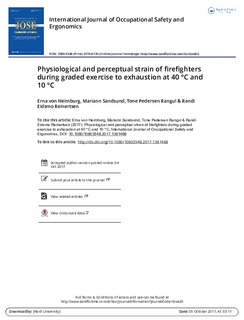Physiological and perceptual strain of firefighters during graded exercise to exhaustion at 40 and 10°C
Journal article, Peer reviewed
Accepted version
Permanent lenke
http://hdl.handle.net/11250/2487316Utgivelsesdato
2017Metadata
Vis full innførselSamlinger
Originalversjon
von Heimburg, E. D., Sandsund, M., Rangul, T. P. & Reinertsen, R. E. (2017). Physiological and perceptual strain of firefighters during graded exercise to exhaustion at 40 and 10°C. International Journal of Occupational Safety and Ergonomics,. doi: 10.1080/10803548.2017.1381468Sammendrag
Purpose. To study whether perceptual identification should be included as a measure to evaluate physiological stress.
Methods. Physiological variables oxygen uptake (VO2), ventilation, heart rate, blood lactate concentration, rectal temperature (Trec) and mean skin temperature, and perceptual variables rate of perceived exertion, thermal sensation and time to exhaustion, were measured at submaximal and maximal intensities during graded exercise on a treadmill to exhaustion in 12 firefighters wearing protective clothing and extra mass at 40 and 10 °C. Physiological strain index (PhSI) and perceptual strain index (PeSI) were calculated.
Results. Apart from Trec, all physiological and perceptual variables were higher at submaximal intensities of 40 °C. Time to exhaustion was 16% shorter and the corresponding VO2 was reduced by 7% in the heat. A high correlation (r = 89) between PhSI and PeSI was found at both temperatures. PeSI scores were equal to PhSI at both ambient temperatures, except at the two highest intensities in the heat, where PeSI was higher.
Conclusions. These findings support use of perceptual identification to evaluate physiological stress. However, at very high intensities under hot conditions the perceptual strain was estimated higher than the physiological strain. More precise indexes are needed to include perceptual measures in safety standard.
